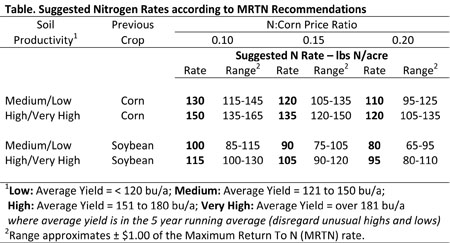Test it out: MSU’s MRTN corn nitrogen recommendations
Applying more nitrogen to your corn may increase yield, but that doesn’t always mean a fatter wallet.
Input costs and commodity prices might be on the rise, but that doesn’t mean that your corn nitrogen (N) application rates should be too. In fact, studies in the past 10 years have shown our new corn hybrid varieties are more effective at utilizing the nitrogen available to them for grain production. On average, these hybrids require only approximately 0.8 lbs of nitrogen to produce one bushel of corn compared to 1.1 to 1.2 lbs of nitrogen per bushel of corn with the older varieties. In short, our corn varieties are getting better at using nitrogen, which gives us opportunity to apply less and save dollars.
MSU’s relatively new corn nitrogen recommendations are based on the concept of Maximum Return To Nitrogen (MRTN). These recommendations follow the idea that at some point the additional cost of nitrogen needed to increase the corn yield one bushel will be greater than the increased income from that one bushel of corn. The table below displays the suggested nitrogen rates according to the MRTN recommendations. Three factors play into the recommendations: previous cropping history, soil productivity, and nitrogen to corn price ratio ($/lb nitrogen ÷ $/bu corn). The resulting suggested N rates are significantly lower than previous recommendations, which would be expected with the new, more nitrogen efficient corn hybrids in today’s markets.
Lower recommended nitrogen rates are not an easy idea for corn growers to accept and incorporate out in the field. However, an on-farm strip trial may help build confidence in the lower rates. Within a single field with a consistent variety of corn, a grower could apply strips of nitrogen at both their old nitrogen rate and the nitrogen rate suggested in the table below, repeating this multiple times across the field. At harvest time, a yield monitor or a weigh wagon can easily be used to compare corn yield and the resulting economic return can then be calculated.
Additionally, growers can look to past years research to evaluate corn yield response to nitrogen application rates. Many MSUE Educators across the state have conducted trials, these studies can be found in the January 2011 edition of the Field Crops Team On-farm Research and Demonstration booklet, available at most MSU Extension offices, and in the Thumb Ag Research and Education 2010 Field Trial booklet.




 Print
Print Email
Email



